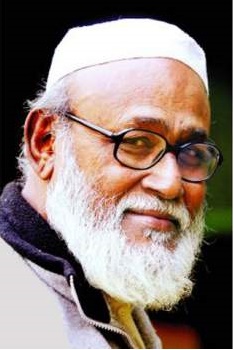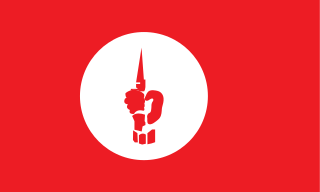Notes and references
Notes
- ↑ Islam 2007 , pp. 435–437
- ↑ Islam 2007 , p. 445
- ↑ Islam 2007 , pp. 440–445
Related Research Articles

The Bangladesh Liberation War, also known as the Bangladesh War of Independence and known as the Liberation War in Bangladesh, was an armed conflict sparked by the rise of the Bengali nationalist and self-determination movement in East Pakistan, which resulted in the independence of Bangladesh. The war began when the Pakistani military junta based in West Pakistan—under the orders of Yahya Khan—launched Operation Searchlight against the people of East Pakistan on the night of 25 March 1971, initiating the Bangladesh genocide.

Independence of Bangladesh was declared on 26 March 1971, celebrated as Independence Day, from Pakistan. The Independence Day of Bangladesh is celebrated on 26 March when Sheikh Mujibur Rahman declared the independence of Bangladesh. The Bangladesh Liberation War started on 26 March and lasted till 16 December 1971 which is celebrated as Victory Day in Bangladesh. There is a dispute along partisan line on who declared the Independence of Bangladesh. The Awami League claim Sheikh Mujibur Rahman while the Bangladesh Nationalist Party claim it was Ziaur Rahman.

Banglapedia:theNational Encyclopedia of Bangladesh is the first Bangladeshi encyclopedia. It is available in print, CD-ROM format and online, in both Bengali and English. The print version comprises fourteen 500-page volumes. The first edition was published in January 2003 in ten volumes by the Asiatic Society of Bangladesh. with a plan to update it every two years. The second edition was issued in 2012 in fourteen volumes.

Muhammad Ataul Gani Osmani was a Bangladeshi military officer and revolutionary. His military career spanned three decades, beginning with his service in the British Indian Army in 1939. He fought in the Burma Campaign during World War II, and after the partition of India in 1947, he joined the Pakistan Army and served in the East Bengal Regiment, retiring as a colonel in 1967. Osmani joined the Provisional Government of Bangladesh in 1971 as the commander-in-chief of the nascent Bangladesh Forces. Regarded as the founder of the Bangladesh Armed Forces, Osmani retired as the first full general from the Bangladesh Army in 1972.

The Liberation War Museum is a museum at Agargaon in Dhaka, the capital of Bangladesh, which commemorates the Bangladesh Liberation War that led to the independence of Bangladesh from Pakistan.
As in many countries, the science, craft, and art of photography in Norway has evolved as a result of changing technology, improving economic conditions, and the level of acceptance of photography as an art form in its own right.

Manzoor Alam Beg was a Bangladeshi photographer. He was awarded Ekushey Padak in 2007 by the Government of Bangladesh.
East Bengali Refugees are people who left East Bengal following the Partition of Bengal, which was part of the Independence of India and Pakistan in 1947. An overwhelming majority of these refugees and immigrants were Bengali Hindus. During the Bangladesh liberation war with West Pakistan, an estimated ten million people of East Pakistan fled the country and took refuge in India particularly in the Indian states of West Bengal and Indian North East region, especially Tripura and Assam.

Shahbagh is a major neighbourhood and a police precinct or thana in Dhaka, the capital and largest city of Bangladesh. It is also a major public transport hub. It is a junction between two contrasting sections of the city—Old Dhaka and New Dhaka—which lie, respectively, to its south and north. Developed in the 17th century during Mughal rule in Bengal, when Old Dhaka was the provincial capital and a centre of the flourishing muslin industry, it came to neglect and decay in early 19th century. In the mid-19th century, the Shahbagh area was developed as New Dhaka became a provincial centre of the British Raj, ending a century of decline brought on by the passing of Mughal rule.
Altaf Mahmud was a musician, cultural activist, and martyred freedom fighter of the Bangladesh Liberation War. He was also a language activist of the Language Movement and composer of "Amar Bhaier Rokte Rangano", the famous song written to commemorate the event.

Mymensingh Zilla School, also known as MZS, is a boys' public secondary school in Mymensingh, Bangladesh. The school was established as Hardinge School during the British Raj in 1846 and got its current name, Mymensingh Zilla School on 3 November 1853.

The independence of Bangladesh was declared on 26 March 1971, at the onset of the Bangladesh Liberation War by Bangabandhu Sheikh Mujibur Rahman; the following day the declaration was broadcast by Major Ziaur Rahman from Swadhin Bangla Betar Kendra radio station in Kalurghat, Chattogram. On 10 April, the Provisional Government of Bangladesh issued a proclamation on the basis of the previous declaration and established an interim constitution for the independence movement.

Bangladesh Jamaat-e-Islami, previously known as Jamaat-e-Islami Bangladesh, or Jamaat for short, is the largest Islamist political party in Bangladesh. On 1 August 2013, the Bangladesh Supreme Court cancelled the registration of the Jamaat-e-Islami, ruling that the party is unfit to contest national elections. It was fully banned by Government on 1 August 2024.

Ashfaque Munier was a Bangladeshi media specialist and broadcast journalist. He was known for his photography direction and for being the cofounder of the global news channel The Real News Network. He was one of three sons of Munier Chowdhury. Mishuk served as the chief executive officer and chief editor of satellite TV channel ATN News. He died in a road accident, along with Tareque Masud, on August 13, 2011. He was awarded Ekushey Padak for his contribution to journalism in 2012 by the Bangladeshi government.

Martyred Intellectuals Day is observed on 14 December in Bangladesh to commemorate the large number of Bangladeshi intellectuals killed by Pakistani forces and their collaborators during the Bangladesh Liberation War, particularly on 25 March and 14 December 1971. The killings were undertaken with the goal of annihilating the intellectual class of what was then East Pakistan. Two days after the events of 14 December on 16 December, Bangladesh became independent through the surrender of Pakistani forces.

Rashid Talukder was a Bangladeshi photojournalist for The Daily Ittefaq, most known for capturing some of the defining images of the genocide during the Bangladesh Liberation War of 1971.

The Mukti Bahini, also known as the Bangladesh Forces, was the guerrilla resistance movement consisting of the Bangladeshi military, paramilitary and civilians during the Bangladesh Liberation War that transformed East Pakistan into Bangladesh in 1971. They were initially called the Mukti Fauj.

Bangladeshi art is a form of visual arts that has been practiced throughout the land of what is now known as Bangladesh. Bangladeshi art has a perennial history which originated more than two thousand years ago and is practiced even to this date. Among the various forms of Bangladeshi art, photography, architecture, sculpture and painting are the most notable.

Muktijuddho e-Archive, also known as Bangladesh Liberation War e-Archive, is a 'Library, Archive & Research' organization, founded in 2007, working with collection, preservation & distribution of historical documents & research on the Liberation War of Bangladesh and Genocide of Innocent Bengali People in 1971. It was previously known as 'Bangladesh Liberation War Library & Research Centre', later on March, 2016, it was registered under existing Trust Law of Bangladesh as 'Muktijuddho e-Archive Trust'. On 14 November 2016, it was officially inaugurated.
Noazesh Ahmed was a Bangladeshi geneticist and photographer.